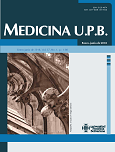Toxidrome sedante versus enfermedad cerebrovascular: a propósito de un caso
Contenido principal del artículo
Resumen
Describimos el caso de una paciente femenina con signos y síntomas iniciales poco específicos, con alteración en el estado de conciencia. Se sospechó posible intoxicación, por nexo causal, probablemente por amitraz versus benzodiacepinas, sin embargo, sin confirmación de este. La paciente tenía alteración del sistema nervioso central con síntomas sugestivos de síndrome neurovascular, con posible compromiso de circulación posterior. La importancia de este caso es resaltar el amplio espectro de presentación clínica de las enfermedades neurológicas, la importancia de realizar diagnósticos diferenciales considerando los síntomas camaleónicos del accidente cerebrovascular, al igual que los “mimics stroke” y realizar enfoques clínicos integrales.
Citas
Bassin BS, Cooke JL. Depressed consciousness and coma: Marx JA, Hockberger RS, Rosen’s emergency medicine. 8th Edition. 2014. Chapter 16, pp. 141-150
Berrouet MC, Pino NE, Castro M, Gómez UE. Alteración del estado de conciencia en el paciente intoxicado. Med U.P.B 2017;36(1):71-79.
De Paepe P, Lemoyne S, Buylaet W. Disorders of consciousness induced by intoxication. Neurol Clin 2012;30(1):359-384.
Stevens RD, Bhardwaj A. Approach to the comatose patient. Crit Care Med 2006;34(1):31-41.
Jackson AC. Rabies virus infection: An update. J Neurovirol 2003;9(2):253-258.
Stoltenberg M, Schionning JD, Danscher G. Retrograde axonal transport of bismuth: An autometallographic study. Acta Neuropathol (Berl) 2001;101(2):123-128.
Wiley RG, Blessing WW, Reis DJ. Suicide transport: Destruction of neurons by retrograde transport of ricin, abrin, and modeccin. Science 1982;216(4548):889-890.
Ortinski P, Meador KJ. Neuronal mechanisms of conscious awareness. Arch Neurol 2004;61(7):1017-1020.
Laureys S, Owen AM, Schiff ND. Brain function in coma, vegetative state, and related disorders. Lancet Neurol 2004;3(9):537-546
Saunders NR, Knott GW, Dziegielewska KM. Barriers in the immature brain. Cell Mol Neurobiol 2000;20(1):29-40.
Blyth BJ, Bazarian JJ. Traumatic alterations in consciousness: Traumatic brain injury. Emerg Med Clin North Am 2010;28(3):571-594.
Spencer PS. Biological principles of chemical neurotoxicity. In Spencer PS, Schaumburg HH (eds); Experimental and Clinical Neurotoxicology, 2nd ed. New York, Oxford University Press, 2000, pp3-54.
Goforth HW, Fernandez F. Acute neurologic effects of alcohol and drugs. Neurol Clin 2012;30(1):277-284.
Doganay Z, Aygun D, Altintop L, Guven H, Bildik F. Basic toxicological approach has been effective in two poisoned patients with amitraz ingestion: Case reports. Hum Exp Toxicol 2002;21(1):55-7
Ulukaya S, Demirag K, Moral AR. Acute amitraz intoxication in human. Intensive Care Med 2001;27(5):930-933.
Liberman AL, Prabhakaran S. Stroke chameleons and stroke mimics in the emergency department. Curr Neurol Neurosci Rep 2017;17(2):15.
Anathhanam S, Hassan A. Mimics and chameleons in stroke. Clin Med Lond Engl 2017;17(2):156-160.
Lever NM, Nystrom KV, Schindler JL, Halliday J, Wira C, Funk M. Missed opportunities for recognition of ischemic stroke in the emergency department. J Emerg Nurs 2013;39(5):434–439.
Lo WD, Kumar R. Arterial Ischemic Stroke in Children and Young Adults. Contin Minneap Minn 2017;23(1):158-180.
Kunst MM, Schaefer PW. Ischemic stroke. Radiol Clin North Am 2011;49(1):1-26.
Kuruvilla A, Bhattacharya P, Rajamani K, Chaturvedi S. Factors associated with misdiagnosis of acute stroke in young adults. J Stroke Cerebrovasc Dis Off J Natl Stroke Assoc 2011;20(6):523-527.


